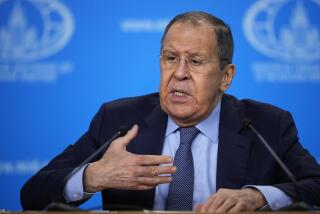Kremlin Official Asserts Soviets Wouldn’t Oppose ‘Star Wars’ Lab Research
- Share via
GENEVA — Under the latest Kremlin arms proposal, the United States could continue to conduct the same space defense research work in laboratories as at present, a senior Soviet official said here Tuesday.
“The Soviet side has never meant and does not mean to place any restrictions on basic research,” Deputy Foreign Minister Vladimir F. Petrovsky told the 40-nation disarmament conference here.
But in seeking to draw “a line between permitted and prohibited” research in an amended Anti-Ballistic Missile Treaty, Petrovsky said, “we only suggest not to go beyond threshold laboratory research, the threshold already reached by the United States.”
In a press conference later, he added that “prototypes and mockups should be prohibited,” referring to technical descriptions of devices that may be in laboratory size or larger, and which are used to prove the feasibility of concepts as they move through the development process.
Ending Fifth Round
Petrovsky’s comments appeared to be a significant elaboration on Soviet proposals made in recent weeks at the U.S.-Soviet arms negotiations here, which are winding up their fifth and most fruitful round this week.
It is not clear whether Petrovsky’s explanation of the limitations the Soviets want on space defense research work, which the Administration is pursuing under its Strategic Defense Initiative (or “Star Wars”) program, has yet been presented to the bilateral arms talks, where Soviet offers sometimes follow rather than precede their public announcement.
The Soviet change regarding space research was part of its new package, unveiled in three separate moves between May 29 and June 11. In it, the Soviets called for each side to extend the ABM treaty by at least 15 years. Either side may now end compliance with the pact after six months’ notice.
Strategic Cutback
At the same time, the Soviets called for reduction in strategic offensive missiles and bombers by about 33%, to 8,000 warheads and bombs on both sides.
Moscow earlier offered a 50% cut in warheads while demanding a total ban on space defense work. Both of its offers are still on the table, and it is likely that any U.S. counterproposal will pick the best features, from its point of view, from the two schemes.
Petrovsky also said that the newer Moscow proposal represented “an intermediate measure” and that the 8,000-warhead ceiling would exclude medium-range weapons.
As with their position on space defense research, the Soviets made much of this “concession” on medium-range missiles. But in both cases, U.S. officials in Washington have felt that the original Soviet stands were untenable and are not inclined to give Moscow much credit on those specific points now.
Pre-Summit Agreement
However, the latest Soviet proposal is lauded for having cleared the way for serious bargaining when the talks resume in September and perhaps even during the summer recess if the two sides want a significant agreement in the arms control field before the next U.S.-Soviet summit, which is expected in November or December.
The new Soviet offer, almost in passing, has also raised difficult counting problems with regard to the ceiling of 8,000 long-range warheads and bombs.
The Soviets want to count the warheads on long-range land-based and submarine-based ballistic missiles, the long-range cruise missiles on submarines and heavy bombers, and the short-range missiles and bombs on the same bombers.
Expectations are that Moscow in time will give up its demand to count the short-range missiles and bombs, and rules have previously been thrashed out on ways to limit the number of cruise missiles on bombers to about 20, which are mostly visible anyway.
Extremely Difficult
But counting the number of cruise missiles in an underwater submarine will be extremely difficult and complicated.
The Soviets have proposed a so-called volumetric measuring system, in which a submarine equipped with cruise missiles will be counted as carrying the largest number of missiles that can be packed into its volume, after deductions are made for its engine, ballast and crew, according to sources.
Whether such calculations will suffice to produce a verifiable agreement is unclear, but in the process, the two sides may be moving toward creating at least two classes of warheads--those on fast-flying ballistic missiles and those on slow, winged cruise missiles.
More to Read
Sign up for Essential California
The most important California stories and recommendations in your inbox every morning.
You may occasionally receive promotional content from the Los Angeles Times.













